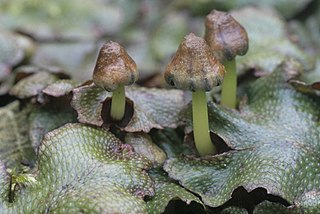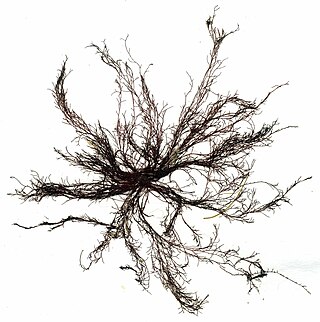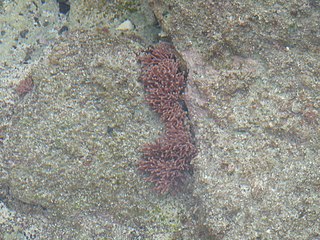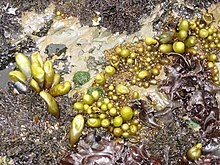
A gametophyte is one of the two alternating multicellular phases in the life cycles of plants and algae. It is a haploid multicellular organism that develops from a haploid spore that has one set of chromosomes. The gametophyte is the sexual phase in the life cycle of plants and algae. It develops sex organs that produce gametes, haploid sex cells that participate in fertilization to form a diploid zygote which has a double set of chromosomes. Cell division of the zygote results in a new diploid multicellular organism, the second stage in the life cycle known as the sporophyte. The sporophyte can produce haploid spores by meiosis that on germination produce a new generation of gametophytes.

Alternation of generations is the predominant type of life cycle in plants and algae. In plants both phases are multicellular: the haploid sexual phase – the gametophyte – alternates with a diploid asexual phase – the sporophyte.

Brown algae are a large group of multicellular algae comprising the class Phaeophyceae. They include many seaweeds located in colder waters of the Northern Hemisphere. Brown algae are the major seaweeds of the temperate and polar regions. Many brown algae, such as members of the order Fucales, commonly grow along rocky seashores. Most brown algae live in marine environments, where they play an important role both as food and as a potential habitat. For instance, Macrocystis, a kelp of the order Laminariales, may reach 60 m (200 ft) in length and forms prominent underwater kelp forests that contain a high level of biodiversity. Another example is Sargassum, which creates unique floating mats of seaweed in the tropical waters of the Sargasso Sea that serve as the habitats for many species. Some members of the class, such as kelps, are used by humans as food.

A sporophyte is the diploid multicellular stage in the life cycle of a plant or alga which produces asexual spores. This stage alternates with a multicellular haploid gametophyte phase.

Palmaria palmata, also called dulse, dillisk or dilsk, red dulse, sea lettuce flakes, or creathnach, is a red alga (Rhodophyta) previously referred to as Rhodymenia palmata. It grows on the northern coasts of the Atlantic and Pacific Oceans. It is a well-known snack food. In Iceland, where it is known as söl, it has been an important source of dietary fiber throughout the centuries.

Laminaria is a genus of brown seaweed in the order Laminariales (kelp), comprising 31 species native to the north Atlantic and northern Pacific Oceans. This economically important genus is characterized by long, leathery laminae and relatively large size. Some species are called Devil's apron, due to their shape, or sea colander, due to the perforations present on the lamina. Others are referred to as tangle. Laminaria form a habitat for many fish and invertebrates.

Conocephalum is a genus of complex thalloid liverworts in the order Marchantiales and is the only extant genus in the family Conocephalaceae. Some species of Conocephalum are assigned to the Conocephalum conicum complex, which includes several cryptic species. Conocephalum species are large liverworts with distinct patterns on the upper thallus, giving the appearance of snakeskin. The species Conocephalum conicum is named for its cone-shaped reproductive structures, called archegoniophores. Common names include snakeskin liverwort, great scented liverwort and cat-tongue liverwort.
Plant reproduction is the production of new offspring in plants, which can be accomplished by sexual or asexual reproduction. Sexual reproduction produces offspring by the fusion of gametes, resulting in offspring genetically different from either parent. Asexual reproduction produces new individuals without the fusion of gametes, resulting in clonal plants that are genetically identical to the parent plant and each other, unless mutations occur.

Dictyotales is a large order in the brown algae containing the single family Dictyotaceae. Members of this order generally prefer warmer waters than other brown algae, and are prevalent in tropical and subtropical waters thanks to their many chemical defenses to ward off grazers. They display an isomorphic haplodiploid life cycle and are characterized by vegetative growth through a single apical cell. One genus in this order, Padina, is the only calcareous member of the brown algae.

Postelsia palmaeformis, also known as the sea palm or palm seaweed, is a species of kelp and classified within brown algae. It is the only known species in the genus Postelsia. The sea palm is found along the western coast of North America, on rocky shores with constant waves. It is one of the few algae that can survive and remain erect out of the water; in fact, it spends most of its life cycle exposed to the air. It is an annual, and edible, though harvesting of the alga is discouraged due to the species' sensitivity to overharvesting.
Sporogenesis is the production of spores in biology. The term is also used to refer to the process of reproduction via spores. Reproductive spores were found to be formed in eukaryotic organisms, such as plants, algae and fungi, during their normal reproductive life cycle. Dormant spores are formed, for example by certain fungi and algae, primarily in response to unfavorable growing conditions. Most eukaryotic spores are haploid and form through cell division, though some types are diploid sor dikaryons and form through cell fusion.we can also say this type of reproduction as single pollination

Polysiphonia, known as red hair algae, is a genus of filamentous red algae with about 19 species on the coasts of the British Isles and about 200 species worldwide, including Crete in Greece, Antarctica and Greenland. Its members are known by a number of common names. It is in the order Ceramiales and family Rhodomelaceae.
This page provides a glossary of plant morphology. Botanists and other biologists who study plant morphology use a number of different terms to classify and identify plant organs and parts that can be observed using no more than a handheld magnifying lens. This page provides help in understanding the numerous other pages describing plants by their various taxa. The accompanying page—Plant morphology—provides an overview of the science of the external form of plants. There is also an alphabetical list: Glossary of botanical terms. In contrast, this page deals with botanical terms in a systematic manner, with some illustrations, and organized by plant anatomy and function in plant physiology.

Heterospory is the production of spores of two different sizes and sexes by the sporophytes of land plants. The smaller of these, the microspore, is male and the larger megaspore is female. Heterospory evolved during the Devonian period from isospory independently in several plant groups: the clubmosses, the ferns including the arborescent horsetails, and progymnosperms. This occurred as part of the process of evolution of the timing of sex differentiation. Four extant groups of plants are heterosporous; Selaginella, Isoetes, Salviniales and seed plants.

Amphiroa is a genus of thalloid red algae under the family Corallinaceae.

Cordylecladia erecta is a species of red algae in the family Rhodymeniaceae. It is found in the north east Atlantic Ocean and the Mediterranean Sea and is the type species of the genus.

Scytothamnus australis is a brown alga species in the genus Scytothamnus found in New Zealand. It is a sulphated polysaccharide and the type species in the genus.

Climacium dendroides, also known as tree climacium moss, belongs in the order Hypnales and family Climaciaceae, in class Bryopsida and subclass Bryidae. It is identified as a "tree moss" due to its distinctive morphological features, and has four species identified across the Northern Hemisphere. The species name "dendroides" describes the tree-like morphology of the plant, and its genus name came from the structure of the perforations of peristome teeth. This plant was identified by Weber and Mohr in 1804. They often have stems that are around 2-10 cm tall and growing in the form of patches, looking like small palm-trees. They have yellow-green branches at the tip of stems. The leaves are around 2.5-3 mm long, with rounder stem leaves and pointier branch leaves. Their sporophytes are only abundant in late winter and early spring, and appears as a red-brown shoot with long stalk and cylindrical capsules.

Mastocarpus papillatus, sometimes called Turkish washcloth, black tar spot, or grapestone is a species of red algae in the family Phyllophoraceae. It is sometimes confused with the distantly related Turkish towel which is of a similar texture but larger. The specific epithet papillatus is due to the nipple-like projections on the female gametophyte which can give the texture of a terrycloth washcloth found at a Turkish bath.
Crustaphytum is a genus of red alga first discovered in Taoyuan algal reefs by Taiwanese scientists. The epithet “crusta” refers to crustose thallus and “phytum” refers to plant. Belonging to the family Hapalidiaceae in the order Hapalidiales, Crustaphytum is one kind of crustose coralline algae.
















